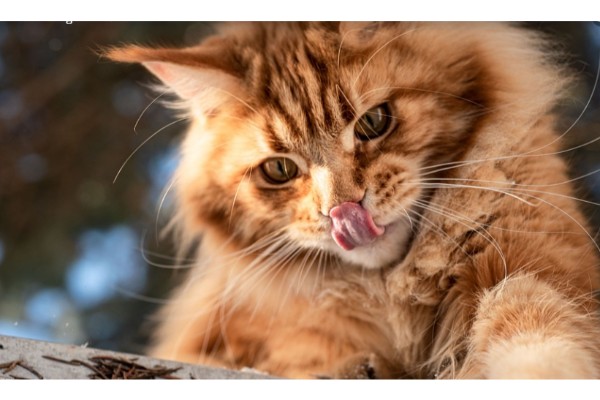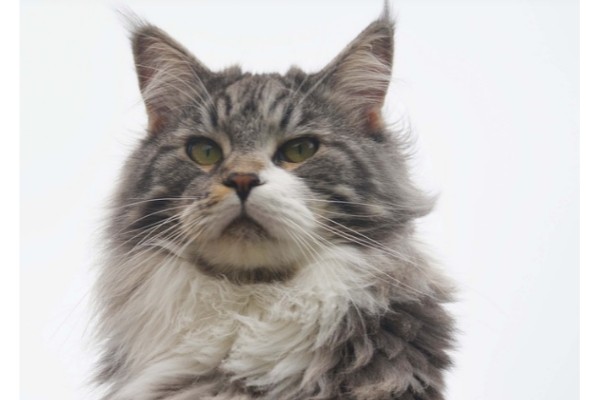Compared to humans, cats have a better sense of smell. They have a sense of smell that is 14 times stronger than ours and can detect smells up to 4 miles away. It is understandable why cats are good hunters when you consider all that goes into their sense of smell. From a few blocks away, they can locate food sources.
Table of Contents
How Far Can Cats Detect Their Owners’ Scents?
Cats can smell their owners from up to four miles away, according to one study, despite the paucity of available research. Natural homing instincts in cats account for some missing cats turning up at their owners’ front doors the following day.
Depending on the cat, this instinct may be stronger or weaker. Not all cats will be able to locate their owners as quickly or at all. Although there isn’t concrete evidence to support how this instinct operates, magnetic geolocation is thought to be involved.
The question of whether cats could successfully find their way back home through a maze was investigated in 1954. The majority of cats could wind up close to their homes, but not if they were wearing magnets. This suggests that scent cues and magnetic geolocation are both important for a cat to be able to smell and find its owner.

How Far Can Cats Smell Dry Food
Cats are highly excited whenever you open a new bag of kibble because they can smell dry food. Numerous variables may affect how far they can detect the aroma of this food.
Your cat probably has a decent sense of smell and can detect kibble fairly far away. It’s difficult to say for sure, but some claim that they can smell things like cat litter and kibble from a mile or further away.
How far away your cat can smell their favorite dry food is also influenced by other elements, such as how strongly scented the food is, how much air is moving, and how many other scents are in the air.
It’s difficult to provide a reliable estimate because of how complicated it is. Some cats may be able to smell their kibble for hundreds of feet, while others may not smell much at all once they are a few rooms away.
Your cat won’t be able to smell their dry food from as far away as their wet food, which may be part of the reason they are more likely to beg for wet food than dry. Dry food also probably emits less scent than wet food, so they won’t be able to smell their dry food from as far away as their wet food.
Your dry food’s shelf life is also important. Dry food tends to become drier and stickier as it ages. As the aromas from dry food leak into the air and leave the food over time, they may start to dry out. This means that a fresh bag of kibble will likely be easier for your cat to smell than an old one.
Your cat may be better able to detect the scent of kibbles from a distance if they contain a lot of strongly scented ingredients, such as fish oils.
How Far Can Cats Smell Wet Food
Since wet food has more moisture than kibble, it is likely that cats can detect it from a greater distance. This is because wet food releases scents more readily into the air.
Since there is more scent in the air, it can travel further and is therefore easier for your cat to detect at a distance.
Remember that the 14 times stronger part means that your cat can smell an open can of wet food from 14 times further away than you can. Smells have the ability to spread out in the air, extending the distance.
How Far Can Cats Smell Tuna
All varieties of tuna are delicious to cats because it is a fish with a relatively strong aroma. The most enticing variety may be tuna in a can, but that is only because it resembles wet cat food more than other tuna does in terms of smell, appearance, and sound.
Cats can typically smell anything you can, and they can do so much farther away. Therefore, even the extremely fresh tuna used for sushi and sashimi has a scent that your cat can detect.

What Other Foods Can Cats Smell From A Far Distance
Cats are interesting in that they have fewer tastebuds than people do, and they also do not have as many different kinds of tastebuds. In contrast to humans, cats rely much more on their sense of smell to taste foods, so they probably have a good sense of smell for most foods other than sweets.
Cats may be able to smell sweet foods, particularly the non-sweet flavorings in sweet foods, but they cannot taste sweetness. There is a good chance that cats cannot smell sweetness because their sense of taste is primarily based on smell.
This means that in addition to the usual foods like fish, chicken, duck, and beef, cats can also detect flavors from fruits, vegetables, and seasonings. Cats can detect an odor from a greater distance away. However, compared to other foods, it’s likely that cats can detect the scent of meat proteins from a greater distance.
Why do cats detect meats more strongly than other foods? Considering that cats eat mostly meat.
Cats cannot obtain the majority of their nutrients from sources other than meat because they are obligate carnivores. Since having a keen sense of smell would have been advantageous to cats in the course of their evolutionary history, this also implies that cats are more likely to detect the aroma of meat and chemical markers of meat.
Cats may also be able to detect other scents at a distance, such as onions and garlic, but not for the same reason. Alliums are a plant family that includes garlic, onions, and other dangerous foods that are extremely toxic to cats.
By decreasing the likelihood that cats will accidentally eat any part of those plants, the smell of alliums from a distance can help keep cats safer.
Furthermore, some culinary herbs, such as catnip and rosemary, may be simple for your cat to detect from a distance. They have benefits for your cat and are strongly scented, so that is why. While rosemary is a useful herb for removing fleas and ticks, catnip is entertaining and calming.
If a plant or food is very beneficial for cats or very harmful, they can likely smell it from far away.
How Do Cats Smell So Far?
I think it’s safe to say that everyone agrees that cats have a keen sense of smell. It really is amazing, in a way! It is much more potent than ours, and experts believe that it surpasses canines’ sense of smell altogether. All of the strength comes from the precise way that cats smell. And, interestingly, they have two separate mechanisms in place for detecting odors.
Cats Smell Using Nasal Olfactory Receptors
Cats’ unique scent receptors, or olfactory receptors as they are scientifically known, allow them to detect smells just like people and other animals. These are found inside your cat’s nose and communicate the scent in the environment to the cat’s brain.
Here’s a better look at how these work:
- When your cat breathes in airborne odor molecules, they enter its nasal cavity.
- These molecules break down in the nasal canal mucus.
- This mucus is moved along the nasal canal and to the olfactory receptors by specialized olfactory cells’ tiny finger-like projections, known as cilia.
- The odor molecules attach to the olfactory receptors and cause them to send a signal to the brain informing it of the type of smell that has been detected.
Because there are so many of these receptors, cats have an incredible sense of smell. According to estimates, they have between 45 million to 80 million of these receptors in their little noses. As many as 200 million scent receptors, according to some experts, may exist.
Humans have about 5 million olfactory receptors, which puts this in perspective. Smell intensity and the number of scent receptors are directly correlated. Since cats’ noses contain millions of receptors, they have a very quick and efficient sense of smell.
Cats Smell Using The Vomeronasal Organ
Cats also have a second way of smelling – they use a specialized area located on the roof of their mouths called the vomeronasal organ, otherwise known as Jacobson’s organ. These cells only detect pheromones, which neither their noses nor ours can detect; they don’t smell any other smells at all.
Pheromones are essential for cat communication, in case you didn’t know. No two cats’ pheromones have the same smell because all cats produce pheromones that are distinctive. These pheromones can be detected by other cats and are used to define territory, mark members of their family as part of the pack, and find partners for breeding.
So how exactly does Jacobson’s organ recognize feline pheromones? Simply put, this region on the roof of your cat’s mouth is essentially a dense collection of olfactory sensory cells and receptors.
Just as airborne odors dissolve and bind to receptors in a cat’s nose, pheromones do the same thing:
- Inhaling pheromones and odors, cats breathe in through their mouths.
- These molecules break down in the saliva and attach to the vomeronasal organ’s receptors.
- The receptors inform the brain of what the cat can smell and to whom these pheromones belong by sending signals.
Cats open their mouths to smell using the vomeronasal organ. When they do this, pheromones can enter their mouth and latch onto these sensory cells. The flehmen reaction is what is commonly seen as a snarl or grimace. In fact, many owners mistake it as their cat being disgusted by what they can smell! But in reality, they’re just getting a good whiff.
Cats have an astonishing number of over 30 different scent receptors in this region, which gives them an unmatched ability to detect and recognize odors. Although dogs also have a Jacobson’s organ, these receptor types are only pleasant. This once more demonstrates how acute a cat’s sense of smell is.
Cats, for instance, can detect other cats on you. The distinctive pheromones of other cats will cling to your body when you are around them. There is nothing you can hide from these inquisitive animals because cats can use their vomeronasal organ to detect the scent of this other cat, so your secret will be revealed.
Cats are not only adept at detecting feline scents; they can also detect human pheromones. They won’t know how to use this information, though, and it won’t have much of an impact on how they act.

How Does Smell Compare With A Cat’s Other Senses?
Cats can smell from great distances, and they use this sense religiously every day for things like detecting when their food has been put out and detecting the presence of their own pheromones to feel safe. But just like people, cats also have four additional senses: sight, hearing, touch, and taste.
How do these senses compare to one another? Are cats just as dependent on these other senses, or is their sense of smell more significant?
The differences between each sense are shown in more detail below.
Sense Of Sight
A cat’s sense of sight is inferior to its sense of smell., especially during the day. They are able to recognize basic shapes and motion, but they are unable to discern the finer details that human eyes can. Moreover, they can’t see the full range of colors that we can see. A blind spot right under their noses causes cats to struggle to see objects that are too close, which is another well-known characteristic of cats.
In spite of this, cats are capable of seeing ultraviolet light, a light wave that human eyes are not even capable of detecting. In order to let more light in during the night, their pupils also enlarge incredibly widely. They also have a reflective layer on their eyes, which improves how well they use the light they receive.
Cats have excellent night vision thanks to these three factors, which is important because they spend the majority of their hunting time at dusk and dawn when light levels are low. As a result, even though they may not have an excellent all-around vision, they do have exceptional vision when they need it the most, such as when they are stalking prey at night in search of their next meal.
Sense Of Hearing
A cat has exceptional hearing sense and is much more sensitive than both dogs and people. A cat’s most developed sense is actually hearing. Their large, pointed ears can pick up even the slightest sounds, like a leaf rustling in the wind.
They have an incredible hearing range of 48Hz to 85kHz, one of the broadest ranges among all mammals. Humans can only hear frequencies up to 20 kHz, so this puts things into perspective. Consequently, cats are capable of hearing sounds that are inaudible to human ears because they are extremely high in pitch.
Furthermore, cats are incredibly adept at differentiating between these various tones. They can differentiate between two sounds that are only three inches apart thanks to their extremely fine tuning! They will be able to locate their prey with great accuracy and know exactly where to pounce.
Sense Of Touch
A cat’s sense of touch is again second to none, and they rely on touch heavily when navigating the world by using their whiskers. Cats enjoy being petted because they have touch receptors on other parts of their bodies as well, but the ones on their whiskers are particularly sophisticated.
These whisker touch receptors are so acute that they can pick up even the smallest variations in airflow. This explains why cats frequently appear to be staring off into space; something has probably caught their whiskers! Additionally, a cat’s whiskers aid in size and distance perception, allowing cats to determine whether or not they will fit through a narrow opening.
Sense Of Taste
The only sense thought to be subpar in cats is their sense of taste. On their tongues, cats only have a small number of the 9,000 taste buds that humans have. What’s more, they are missing some taste receptors entirely and are unable to taste anything sweet.
This is believed to be a chance mutation that helped cats and was passed down through years of evolution. It prevents cats from consuming plants and other high-sugar foods by making them unable to taste sweet things. A carnivorous, high-protein diet that satisfies their taste buds and provides them with all the nutrients they require is instead encouraged.
